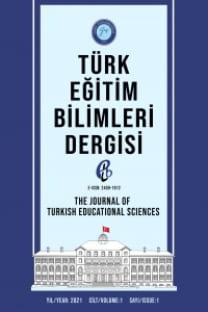SANAT EĞİTİMİNDE BİR PROGRAM ÖNERİSİ: GALERİ EĞİTİMİ PROGRAMI
Müzeler ve Sanat Galerileri, imgelem ve duyguların geliştirilmesi için etkin öğrenme yoluyla kavramları eğlenceli biçimde kullanma olanağı sağlar. Günümüzde müze ve galeriler, eğitim alanında devletin aydınlatıcı sunumunun temel bir aracısı olarak kabul edilmektedir. Bu sunumlar, çeşitli yöntemlerle basitten bileşiğe tekrarlanarak, toplumu bazen eğlendirerek, bazen zorlayarak ciddi ve örnek sergilerle tekrar müze ve galerilere çekip, ziyaret etmeyi bir gelenek haline getirerek gelişir. Bu amaçların göz önünde bulundurulduğu bir Galeri Eğitimi Programının, bireylerin sanatsal gelişimleri üzerinde olumlu etkilere yol açabileceği düşüncesinden yola çıkarak; Galeri Eğitim Programı Uygulamasının sanat eğitimi alan öğrenciler üzerindeki etkileri saptanmaya çalışılmıştır. Bu amaçla İzmir ilindeki bazı İlk ve Orta Öğretim kurumlarındaki 500 öğrenciye anket uygulanmıştır. Sonuçlar değerlendirildikten sonra 50 kişilik deney grubuna 2 yıllık bir süre içinde Galeri Eğitim Programı uygulanmıştır. Program sonucunda anket tekrar uygulanarak verilerin analizinde Statistical Packages for Social Sciences (SPSS) programı ve “t” istatistiği kullanılmıştır. Bulgulara göre; ön anket ve son anket arasındaki fark anlamlıdır.
A SUGGESTED PROGRAMME FOR ART EDUCATION: GALLERY EDUCATION PROGRAM
Museums and Art Galleries provide creative ways of using concepts through active learning so as to improve imaginations and emotions. Today, museums and art galleries are considered official instruments of governments in the field of education. These instruments are sometimes put into order from the simplest to the most sophisticated to entertain the society. They sometimes force people’s minds by presenting serious exhibitions. Art galleries aim at attracting more people and making more visitors come to such art exhibitions Owing to the positive impact of Gallery Education Program upon the artistic development of an individual, it has been aimed to find out the effects of Gallery Education Program practices on the students studying art. For this reason, 500 hundred students from various elementary and secondary schools in İzmir were given a questionnaire. An experiment group of 50 students was involved in Gallery Education Program practices for two years after the results of the questionnaire were received. The questionnaire was re- distributed at the end of the program and the results were analyzed via Statistical Packages for Social Sciences (SPSS) and “t” statistics. According to the results, the difference between pre- questionnaire and post- questionnaire was significant
___
- Çakalöz, O.Z. Elimizi Çabuk Tutmak Zorunday z. Gösteri Dergisi. Say : 24. Demir, R. (2002). Galericilik ve Sanat E itimi. Yay mlanmam Yüksek Lisans Tezi. 'zmir: D Ü
- E itim Bilimleri Enstitüsü. Hooper-Greenhill, E. (1999). Müze ve Galeri E itimi. Çev.: M. Örge Evren ve Gül Kapç .
- Ankara: A.Ü. Çocuk Kül. Ar . ve Uygulama Merkezi Yay nlar . 'yem, N. (1981). Galerilerin Yarar . Hürriyet Gösteri Dergisi. say : 6.
- Tansu , S. (1996). Ça da Türk Sanat . 'stanbul: Remzi Kitabevi.
- Tunal , '. (1982). Türk Resminin Genel Görünümü ve Galerilerimiz. Hürriyet Gösteri Dergisi. Say : 8.
